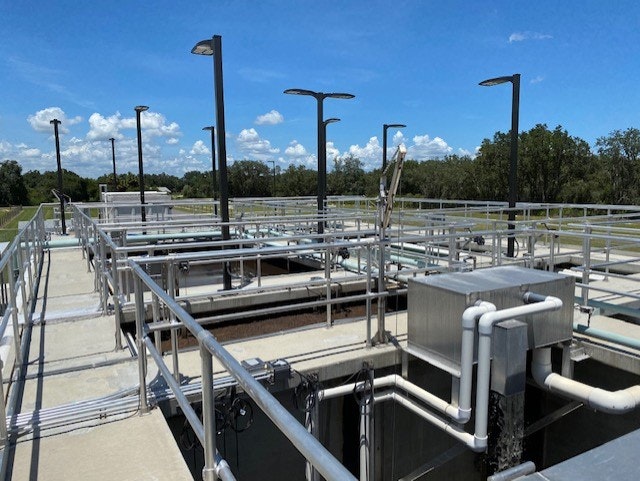Wastewater Plant
Background
For many years the waste water treatment plant was an “accident waiting to happen!” The District Board of Supervisors was aware that over 20% of our residents were on the system, and something had to be done. After several months of negotiations, on March 11, 2015, a Public Hearing took place to discuss a potential purchase, and the Board unanimously agreed to buy the plant. This purchase was made in spite of the fact the Department of Environmental Protection had placed the plant under Administrative Order for not complying with regulations.
For the next six months the District provided in-kind services valued at over $60,000 to make the necessary repairs and upgrades to the plant: personnel; equipment; fuel; supplies; and management. Additionally, the Water Fund provided a loan to the waste water project in the amount of $100,000. This cash infusion enabled the District to meet immediate costs and keep rates and fees stable. The Administrative Order was met in early September, and plans were made to construct a new plant that would be operational by early 2020. The District received $3.2 million at zero interest for 20 years to build a plant and infrastructure. The funds came from the State Revolving Fund; monies made available to communities such as Spring Lake.
The Florida Rural Water Association and our District Engineering Firm, Davidson and Associates, have been instrumental in assisting the District in its efforts to “do the right thing for our community.” The waste water system is an Enterprise Fund, which means that only users of the system actually pay the monthly costs. The Board of Supervisors and District Staff constantly review all aspects of expenditures to ensure that costs are reasonable.
ALL FY '25 GOALS HAVE BEEN MET AND RESULTS ARE AVAILABLE IN THE DISTRICT OFFICE
FY '26 GOALS: All emergency calls Monday thru Friday by 2:00 p.m. will be responded within one hour, and repairs will begin within 24 hours. Weekend repairs will be addressed within one hour if severe, on or the following Monday.




A Homeowner’s Guide to Septic Tank Effluent Pumping (STEP) Systems
Spring Lake Improvement District is providing this information to help you become more familiar with your STEP sewer system. STEP stands for Septic Tank Effluent Pumping. The responsibilities and procedures for maintaining the system is described below
How does a STEP System work?
The STEP System includes a septic tank and a pump. Sewage is conveyed by gravity to the tank through your building plumbing line. Liquid waste is pumped under pressure to the district’s sewer system. Solid waste will remain in the STEP tank where it naturally degrades and is eventually pumped out. STEP system pumps typically turn on every one or two days with normal water use. Spring Lake utility technicians will consult the STEP stysem customer with their knowledge of when a septic tank may need pumping.
Use Water Efficiently
Minimizing water use will save you money in terms of electricity and water cost and will decrease sewer treatment costs for all. You can help minimize water use by using more efficient practices such as:
•Fill the bathtub with only as much water as you need.
•Turn off faucets while brushing your teeth or shaving.
•Turn on the dishwasher and/or clothes washer only when they’re full.
•Make sure all faucets are completely turned off when not in use.
•Install aerators on the faucets in your kitchen and bathroom.
Know your responsibilities:
Label your circuit breakers
Know which circuit breaker at your house supplies power to your STEP pump. Label it so that you don’t accidentally turn it off causing sewage to overflow from the tank. It is your responsibility to provide electric power to the STEP system.
Know the location of your service panel
Be aware of the location of the grey electrical service control panel outside of your building, but don’t tamper with it! If a problem occurs, call the District
Maintain your own plumbing
You are responsible for maintaining the plumbing that connects to the STEP tank. Know what to do in case of a power failure. If a power outage occurs, it is not necessary to call the District. Your system is designed to work normally once power returns.
You Can Help Maintain the STEP System
Top four ways to protect your STEP system:
1. DO call the District at
(863) 655-1715 during office hours or for after hour emergencies, please call 863-655-0615 or 734-777-0989 or 863-655-0596 if you hear or see the STEP system alarm go off.
2. DO consult with SLID personnel on repair and maintaining the system. Don’t try to do it yourself.
3. DON’T use your system for garbage.
4. DON’T dispose of toxic or flammable material into your System. Be careful with undesirable substances that could be flushed into the sewer. Never flush dental floss, fats, oils, grease (FOG), feminine hygiene products, condoms, diapers, wipes, cotton swabs, cigarette butts, coffee grounds, cat litter, or other items that can clog and potentially damage your STEP system. These items should be disposed of in your garbage can. Flushing household chemicals, gasoline, oil, pesticides, antifreeze, and paint can stress or destroy the biological treatment taking place in the system. These items should be taken to the appropriate local hazardous materials handling or recycling station.
Be safe!
Call before you dig
The telephone number of the ‘One Call’ system is 1-800-432-4770. The utilities that have underground facilities in your area will come to surface mark their lines. This is the law!
Do not tamper with your tank
Do not attempt to enter your tank or remove the green access lid. The septic environment creates gases that can cause illness. If your lid has been removed or damaged, let us know and we will repair it in a timely manner
.
Step Tank Responsibilities and Procedures (Adopted by Resolution 2022-03 March 9, 2022)
A Spring Lake STEP (Septic Tank Effluent Pumping) system consist of one septic tank, two submersible pumps, floats that allow pumps to alternate within each other. An electrical panel in which consist of breakers, starters, contacts, timers, high level alarms and wires going to the pumps and floats.
Spring Lake Improvement District will provide the STEP system customers a 24hr 365 days a year on call service that will provide a service to avoid spills or back-ups.
The district duties and responsibilities are as follows:
All electrical equipment. Panels, breakers, starters, contacts, timers, wiring, pumps and floats. Check valves, ball valves and any plumbing connection to our main lines will also be handle and repaired by the district. The district will repair or replace any electrical component in the operating system as needed.
Customer responsibility are as follows:
Supply power to the electrical panel, maintain plumbing from home to tank, pumping of septic tank. The integrity of the STEP tank in which can result in ground water intrusion to our system. Customer is responsible for any issues or problems resulting from tank failures.
Spring Lake utility technicians will consult the STEP system customer with their knowledge of when a septic tank may need pumping.
